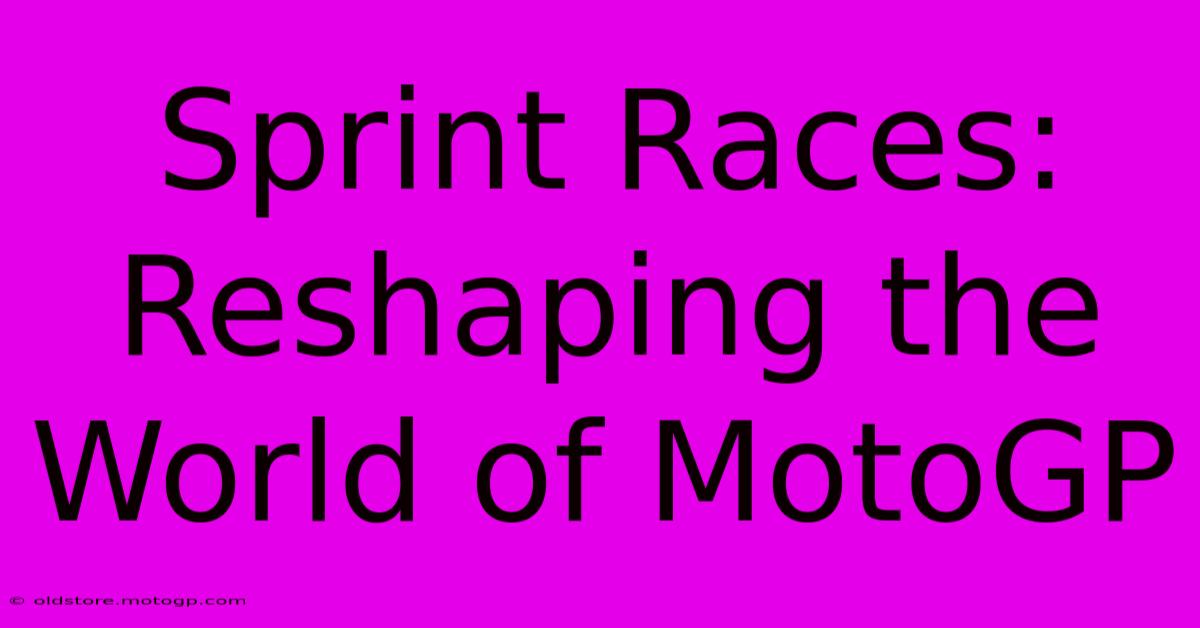Sprint Races: Reshaping The World Of MotoGP

Table of Contents
Sprint Races: Reshaping the World of MotoGP
The roar of the engines, the smell of burning rubber, the heart-stopping overtakes – MotoGP is a spectacle like no other. But in recent years, a significant change has been introduced, one that's sparking debate and reshaping the very fabric of the sport: sprint races. This addition to the Grand Prix weekend format has injected a thrilling new element, altering strategies, increasing the intensity, and potentially changing the future of motorcycle racing. This article delves deep into the impact of sprint races on MotoGP.
The Genesis of Sprint Races in MotoGP
Introduced in 2023, sprint races are a shorter, faster-paced version of the main Grand Prix race. Held on Saturday afternoon, they offer a condensed dose of MotoGP action, lasting around a third of the main race distance. The points awarded for these races are significantly less than the main event but still hold immense value in the overall championship standings. This injection of high-octane action midway through the weekend has proven to be a crucial factor in changing viewer engagement and the overall strategy of the sport.
Why the Change?
The introduction of sprint races wasn't a random decision. Dorma, the governing body for MotoGP, had several goals in mind:
- Increased Fan Engagement: The aim was to provide fans with more track time and racing action throughout the weekend, combating dwindling TV viewership and improving the overall spectator experience.
- Enhanced Championship Dynamics: Sprint races add another layer of competition, altering the championship battle considerably. A win on Saturday can dramatically shift the momentum and pressure going into Sunday's main race.
- More Exciting Qualifying: While the qualifying format has remained largely unchanged, the sprint race results offer valuable insight into race pace, adding a new element of excitement even before the grid positions are set.
- Financial Incentives: More races, even shorter ones, translate to more broadcast opportunities and potential revenue streams for MotoGP.
The Impact of Sprint Races: Positive and Negative
The introduction of sprint races has undeniably been a seismic shift in the MotoGP landscape. While it's brought excitement, it's also sparked controversy and discussion among riders, teams, and fans.
Positive Impacts:
- Increased Excitement and Viewership: The data seems to support Dorna's claims. Sprint races have demonstrably increased viewership and fan engagement, making the MotoGP weekends more action-packed and appealing to a wider audience.
- Strategic Complexity: Teams now need to develop different strategies for Saturday and Sunday, considering tire wear, bike setup, and fuel management across two races. This strategic depth adds a new level of intrigue to the sport.
- Better Understanding of Race Pace: Sprint races provide a better indication of each rider's true race pace compared to a single qualifying session.
Negative Impacts:
- Increased Risk of Injury: More races inherently increase the risk of rider injuries due to higher frequency of crashes and intense racing.
- Tire Wear and Management: The added strain on tires during the sprint race can impact performance during the main Grand Prix, potentially altering the outcome of the more significant race.
- Potential for Reduced Race Day Significance: Some argue the sprint races might overshadow the main event, diminishing the value and prestige of the Sunday Grand Prix.
- Extra Physical Strain on Riders and Teams: The added workload on the riders and their crew is a significant factor that shouldn't be overlooked.
The Future of Sprint Races in MotoGP
The jury is still out on the long-term impact of sprint races. While initial data suggests increased viewer engagement and strategic depth, concerns remain regarding rider safety and the potential to detract from the main race. Dorna is continuously monitoring feedback and adjusting the format as needed, suggesting a willingness to refine the system for optimal results. The success of sprint races will ultimately depend on how well they balance the thrill of added competition with the sustainability of the riders' health and the overall integrity of the championship. The next few seasons will be pivotal in determining whether this significant alteration will truly reshape MotoGP for the better, or if adjustments need to be made to ensure the long-term health and excitement of this beloved motorsport.

Thank you for visiting our website wich cover about Sprint Races: Reshaping The World Of MotoGP. We hope the information provided has been useful to you. Feel free to contact us if you have any questions or need further assistance. See you next time and dont miss to bookmark.
Featured Posts
-
Own A Piece Of Racing History Motorcycles
Feb 25, 2025
-
The Anatomy Of A Motorbike Race Understanding Different Formats
Feb 25, 2025
-
Experience The Thrill Moto 2 Bike Specs
Feb 25, 2025
-
Cota Parking Season Parking Pass Information
Feb 25, 2025
-
How F1 Ratings Can Help You Win Your F1 Bets
Feb 25, 2025
